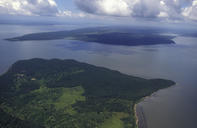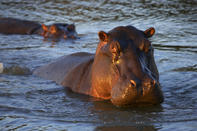Fresh-water Springs
If ever there was a body of open water in South Africa that looked like a lake, it would be this one. It is, in fact, an estuary (the tidal part of a river mouth), and is the largest in all of Africa. Lake St Lucia, in Maputaland, is fed by several medium and small rivers, the biggest of which are the Mkuze and Hluhluwe.

The water from all of them backs up behind a series of coastal dunes covered by grassland and sand forest (the ones at Cape Vidal being reputedly the tallest vegetated dunes in the world). Behind the dunes is a huge basin into which the rivers flow, supplemented in places by fresh-water springs.
You can usually locate these springs by the wildlife that congregates around the pockets of fresh water. The greater ecosystem is incredibly rich in visual and natural elements the habitats including fresh- and saltwater, vegetated dunes, savanna and grasslands. The lake is the heart of this country's first designated UNESCO World Heritage Site, which goes by the most apt name iSimangaliso - the place of miracles.
Terrestrial and Marine Populations

The largest population of reedbuck in South Africa is found in the Eastern Shores reserve of the iSimangaliso Wetland Park. Such has been their breeding success here that cheetah were introduced to control their numbers, and then culling and relocation programmes commenced when the cheetah failed to live up to their job demands.
The St Lucia estuary also has the country's largest populations of hippo and crocodiles, and probably sharks as well should anyone care to count them. The complex is the country's southernmost tropical habitat, hosting 367 species of bird, some 120 marine species including stingray, swordfish and four types of shark, and six types of freshwater fish.
There are 37 different amphibians, 61 reptile species including the deadly gaboon adder and sea snake, as well as loggerhead and leatherback turtles that breed along the northern Zululand coast. iSimangaliso combines eight interlinked ecosystems and three massive lakes comprising 350 km2 of water in total. Still not impressed? The dunes here are up to 25 000 years old, there are 100 species of coral with five distinct cultural groups, whose traditional fish traps date back 700 years.
Did You Know? The wettest-ever recorded spot in South Africa is Cape St Lucia, which got 153,5mm of rain in just one day in December 2004.By David Bristow